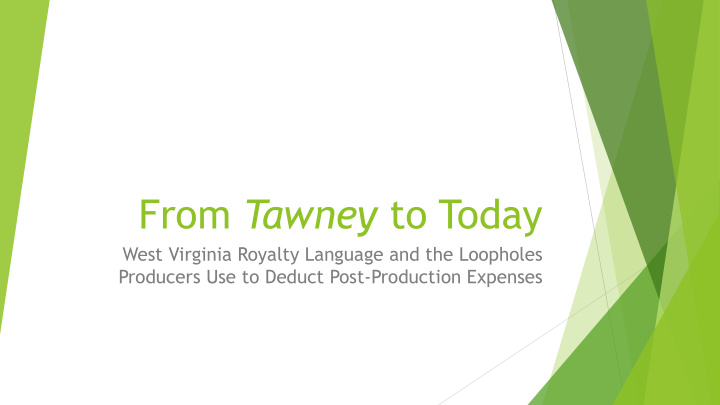



From Tawney to Today West Virginia Royalty Language and the Loopholes Producers Use to Deduct Post-Production Expenses
Before Tawney (2006) u West Virginia recognizes the Marketable Product Rule u Lessee is responsible for all post-production expenses until the oil/gas is “marketable” u What is “marketable”? u Oil/gas is in a processed state suitable for sale u Oil/gas has been transported to the actual place of sale (unique to WV) u Marketable Product Rule is a DEFAULT RULE ONLY ! u The Lessor and the Lessee may agree to shift a pro-rata share of post-production costs to the Lessor under the terms of the oil and gas lease
Tawney (2006) – “At the wellhead” u In essence, the Court was asked to decide whether “at the wellhead” “at the well,” etc. royalty language commonly found in oil and gas leases allowed the Lessee to shift a pro-rata share of post-production costs to the Lessor u Does “at the wellhead” royalty language change the default, Marketable Product Rule? u What does “at the wellhead” mean? Where does it comes from? u Prior to deregulation of the pipeline industry in the 1980s, producers actually sold natural gas “at the well” to 3 rd party pipeline companies u After deregulation , producers constructed their own pipeline systems and gas was no longer sold “at the wellhead” u Despite industry practices, the use of “at the wellhead” royalty language persisted
Tawney (2006) – Arguments of the Parties u Lessors u Because of deregulation, the “at the wellhead” royalty language is ambiguous or silent as to whether the Lessor is responsible for a pro-rate portion of post- production costs u Accordingly, oil and gas leases should be construed against the Lessee and post- production costs should not be shifted to the Lessor u Lessee u Use the Netback Method to calculate what the price of the gas would be “at the wellhead.” u Example: Company A produces the gas and incurs processing costs of $1.00 and transportation costs of $1.50 u Company A sells the gas to a third party for $5.00 and “netbacks” the processing and transportation costs to obtain the price “at the wellhead” of $2.50 ($5.00 - $2.50 = $2.50)
Tawney (2006) – Ruling u Court rules in favor the Lessors u “At the wellhead” language is “ambiguous and, accordingly, is not effective to permit the lessee to deduct from lessor’s…royalty any portion of the costs incurred between the wellhead and the point of sale.” u BIG WIN for Lessors in West Virginia u Lessees are only permitted to deduct for post-production expenses if the lease royalty language: u Identifies with particularity the specific deductions the Lessee intends to take from the Lessor’s royalty AND u Indicate the method of calculating the amount to be deducted from the royalty for such post-production costs
After Tawney (2006) – A Game of Cat and Mouse u Corporate Re-Structuring u Companies break apart into different, discrete legal entities in order to circumvent the Court’s ruling in Tawney u The idea is that one company cannot use the Netback Method, but several, affiliated companies may use the Netback Method to deduct post-production costs. u EQT: The Classic Case u EQT Production : produces the gas “at the wellhead” u EQT Energy : “purchases” the gas from EQT Production u EQT Gathering : transports the gas from the wellhead to the point of sale and “charges” EQT Energy for the costs of doing so u EQT Energy: sells the gas to a third party u EQT Energy then reports a price to EQT Production upon which Lessor’s royalty payments are calculated
Recommend
More recommend